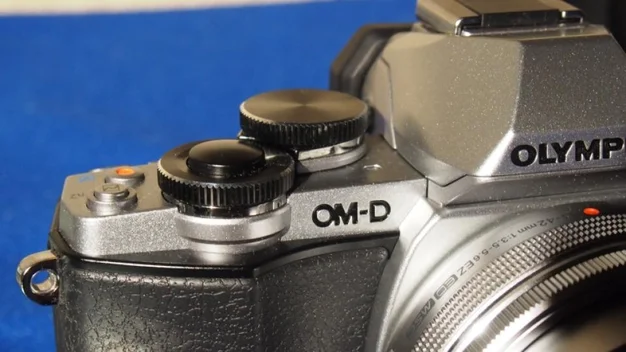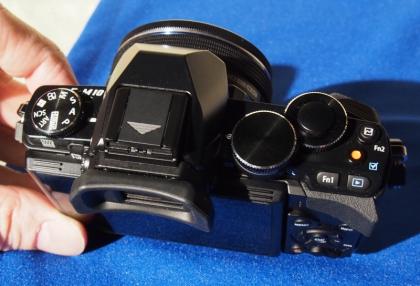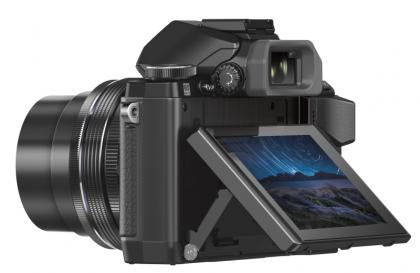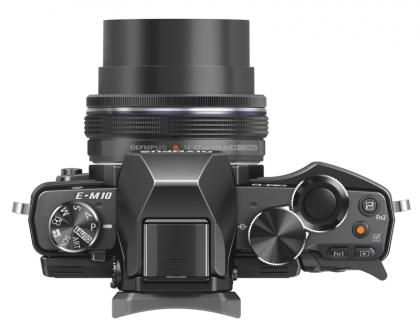Olympus OM-D E-M10 review

The latest mirrorless Olympus lands in a crowded range, but it could be the most appealing yet
Olympus’s range of compact system cameras hasn’t been the easiest to follow. The original, ground-breaking PEN quickly evolved into three ranges for differing needs. Just when we got our heads around that, Olympus pushed the high-end of mirrorless cameras with its OM-D range. The first of these was the catchily named Olympus OM-D EM-5 and that was quickly followed by DSLR-rival EM-1. Now Olympus has introduced a more consumer-friendly model, the Olympus OM-D E-M10, which completes the set – and makes for 6 different strata of mirrorless models from the company.

The new E-M10 in black with its add-on handgrip fitted
OLYMPUS E-M10
All that aside, the OM-D E-M10 is a rather exciting-looking new camera. The retro-styling is immaculate and the body is all metal for a fantastic-feeling finish. There’s an optional grip that attaches under the camera and provides a smart-looking angular handgrip. Controls are plentiful with a mode dial and two control dials, plus a smattering of buttons too. A built-in pop-up flash on top means you can shoot anywhere, plus there’s a hotshoe too. Finally the tripod screw is placed directly below the lens (which it wasn’t on the E-M5) so there’s no problems with panning on a tripod.

The camera itself is very compact, considering the controls packed onto it, and all the buttons and dials felt responsive and well-sized (none of the E-M5’s weather-proofing to complicate things here). We don’t have the exact dimensions but its not much bigger than the GX7, though its hard to compare directly given the very different EVF positioning.
OLYMPUS E-M10 EVF
Olympus is very proud of its new EVF. It runs at a fast 120fps, with just 7-10ms latency. Olympus had a number of persuasive videos to show off, using a metronome to show how its EVF kept up with the real world quicker than Sony’s or Panasonic’s. It looks good too with 1.44m dots, alternatively there’s a titling 3in LCD display.

EVF and tilting touchscreen, so you’ve plenty of freedom when lining up shots
Wi-Fi is built-in to this camera, and you can control both the shutter and the zoom (with power zooms of course) from the app. You can also controls settings, and you have the option to continue to use the full manual settings on the camera even when the app is connected, and then just use it to trigger the shot.
There are a couple of downsides compared to other OM-D models. The built-in pop-up flash means Olympus couldn’t find space for the usual AP2 accessory port. This means there’s no way to attach accessories, though the usual pop-up flash or EVF options are already catered for here. That said, the fact you can’t fit the wacky MAL-1 light or handy SEMA-1 microphone input.
The 5-axis stabilisation system on the E-M5 has been cutback to just 3-axis – with no vertical or horizontal motion compensation, just the usual XYZ twisting. It’s hard to know how much this will affect performance when shooting. To help compensate, electronic stabilisation has been added to steady video, and again Olympus had some impressive videos that showed the E-M10 to be better at balancing out the bumps than the Canon 650D or NEX-6.
OLYMPUS E-M10 SENSOR AND IMAGE PROCESSOR
Inside, it takes the 16-megapixel sensor from the E-M5 and marries it with the TruePic VII image processor used in the E-M1. The former should produce beautiful JPEG images in most conditions, as we rated the E-M5 as among the best mirrorless cameras we’d seen. And good JPEG results is something of an Olympus specialty with the JPEG output providing a ‘rich, radiant glow’ according to us. This is exactly what the kind of person the E-M10 is aimed at will want, as those happy to fiddle with RAW files will likely be happier with one of its larger siblings.

This image from the E-M5, which uses the same sensor, shows just how good a Micro Four Thirds camera can be, with razor sharp details, vibrant colours, but restrained skin tones- click to enlarge
The image processor provides a fast 8fps, which Olympus claim is quicker than any other camera ‘in its class’ though we’re not quite sure what they’re comparing it too here – then again there’s little out there that’s quicker when it comes to mirrorless cameras.
NEW LENSES
The camera will come with a new kit lens, a compact power zoom in the same style as the Panasonic X-series lens. The new 14-42mm lens is just 22.5mm deep (4.3mm less than Panasonic’s) but contains the same number of lens elements as the current kit lens. It wil seriously reduce the overall size of the camera – plus apparently there will be an automatic lens cap option, something we’re abnormally excited about.

You can see here just how compact the new zoom would be when collapsed
We also got to see a new 25mm F1.8 lens, which is well overdue and made from plastic, so it shouldn’t be crazy expensive either. Olympus claim it’s sharper into the corners than the Panasonic equivalent and has a short 25cm minimal focusing distance. Plus there’s a new body lenscap lens, this one provides a fisheye 18mm view, around 140 degree wide angle, a lot of fun for around EUR100.
CONCLUSION
The camera should be available in the UK, with the new kit lens, sometime in February. It looks to be a very persuasive package, possibly better than its competitors, but the competition for high-end mirrorless cameras is intense and the price will have to be right too.
